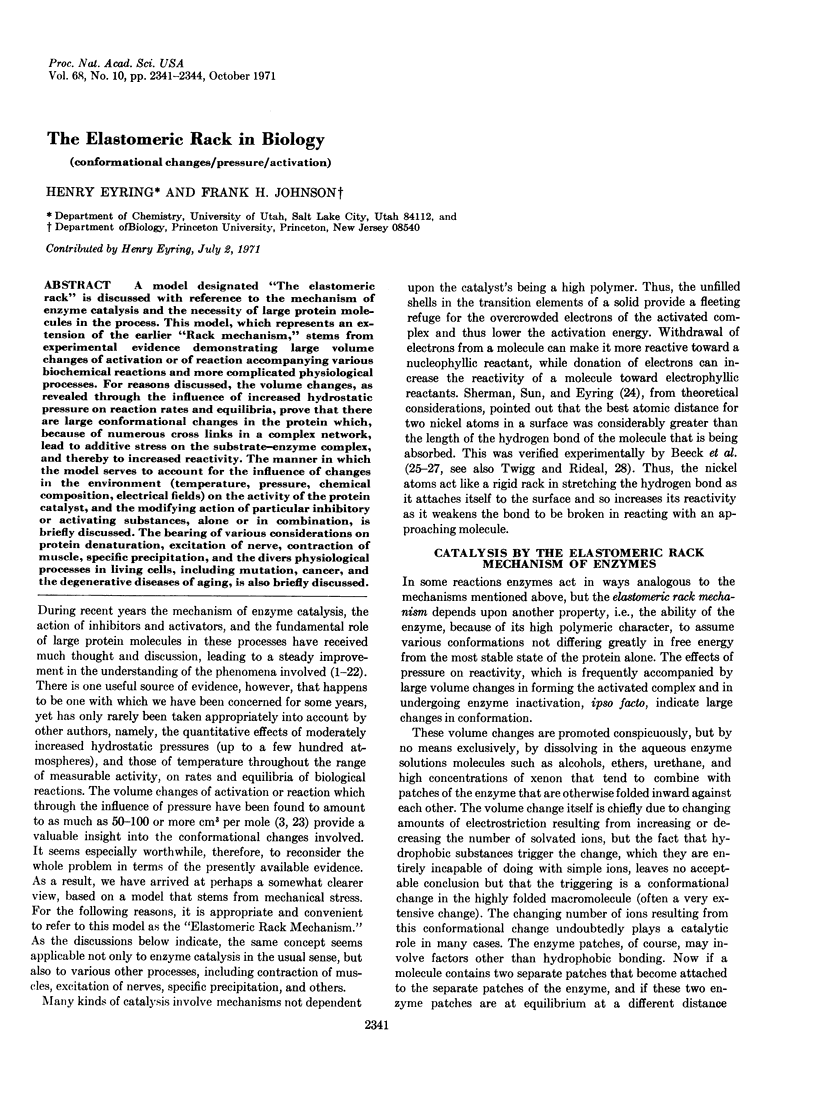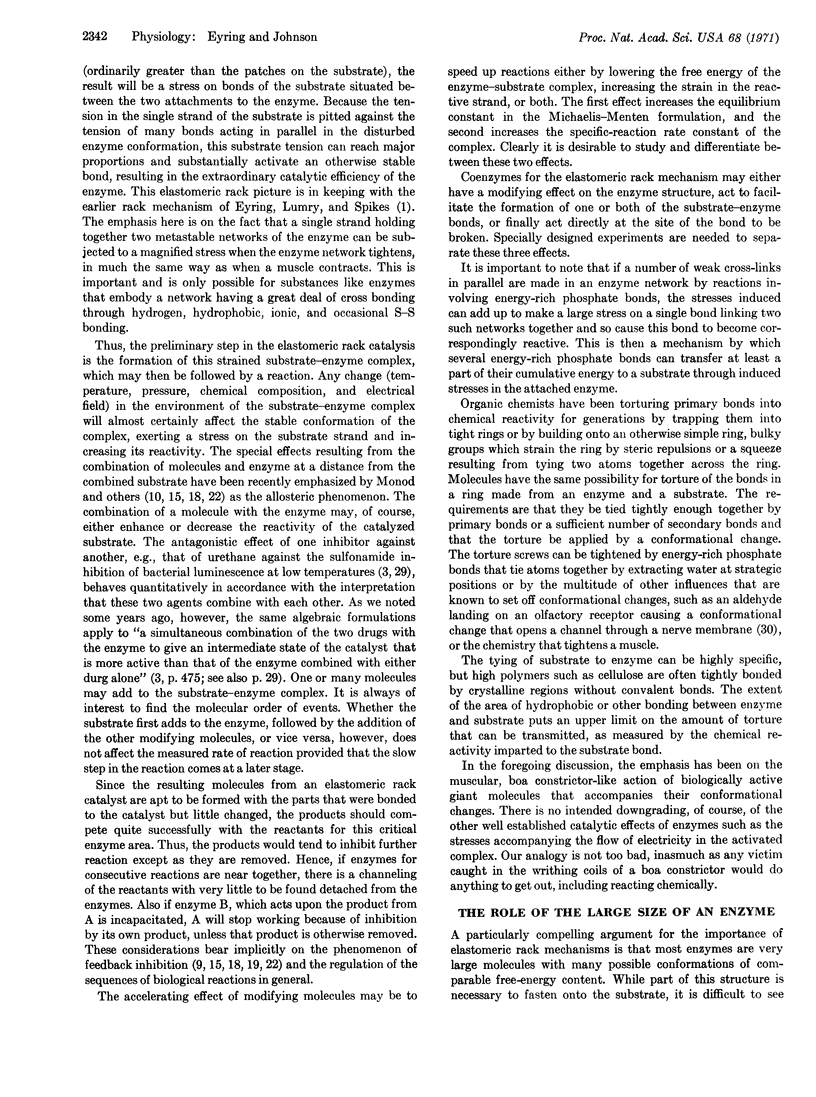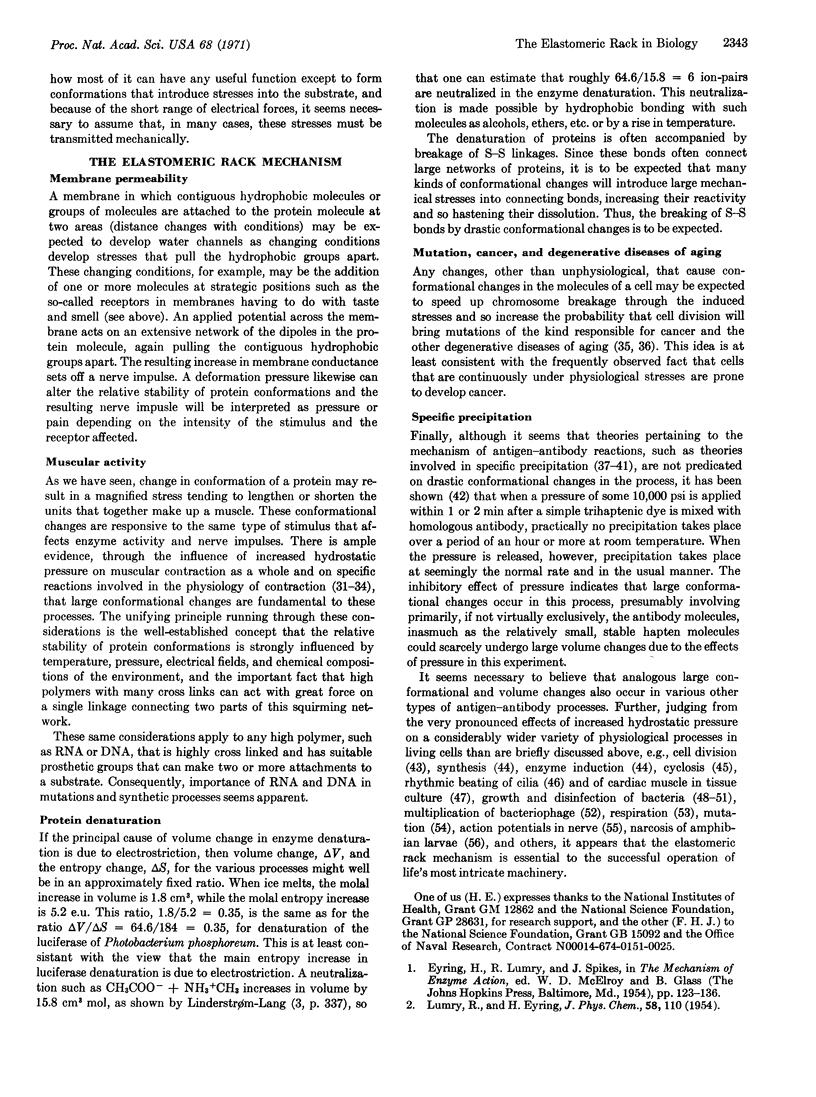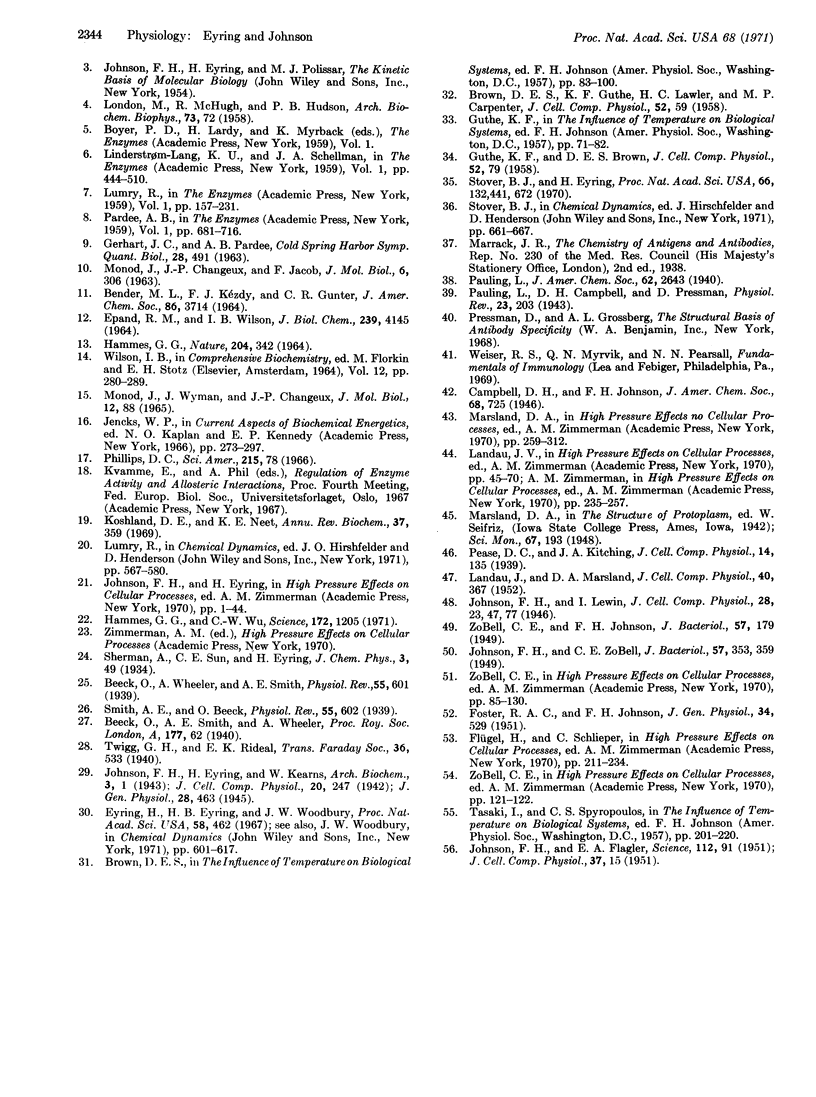Abstract
A model designated “The elastomeric rack” is discussed with reference to the mechanism of enzyme catalysis and the necessity of large protein molecules in the process. This model, which represents an extension of the earlier “Rack mechanism,” stems from experimental evidence demonstrating large volume changes of activation or of reaction accompanying various biochemical reactions and more complicated physiological processes. For reasons discussed, the volume changes, as revealed through the influence of increased hydrostatic pressure on reaction rates and equilibria, prove that there are large conformational changes in the protein which, because of numerous cross links in a complex network, lead to additive stress on the substrate-enzyme complex, and thereby to increased reactivity. The manner in which the model serves to account for the influence of changes in the environment (temperature, pressure, chemical composition, electrical fields) on the activity of the protein catalyst, and the modifying action of particular inhibitory or activating substances, alone or in combination, is briefly discussed. The bearing of various considerations on protein denaturation, excitation of nerve, contraction of muscle, specific precipitation, and the divers physiological processes in living cells, including mutation, cancer, and the degenerative diseases of aging, is also briefly discussed.
Keywords: conformational changes, pressure, activation
Full text
PDF



Selected References
These references are in PubMed. This may not be the complete list of references from this article.
- BROWN D. E., GUTHE K. F., LAWLER H. C., CARPENTER M. P. The pressure, temperature and ion relations of myosin ATP-ase. J Cell Physiol. 1958 Aug;52(1):59–77. doi: 10.1002/jcp.1030520105. [DOI] [PubMed] [Google Scholar]
- EPAND R. M., WILSON I. B. FREE ENERGY CHANGES IN REACTIONS OF CHYMOTRYPSIN WITH SUBSTRATES. J Biol Chem. 1964 Dec;239:4145–4150. [PubMed] [Google Scholar]
- Eyring H., Eyring H. B., Woodbury J. W. Sensitivity and reliability of the senses. Proc Natl Acad Sci U S A. 1967 Aug;58(2):462–469. doi: 10.1073/pnas.58.2.462. [DOI] [PMC free article] [PubMed] [Google Scholar]
- FOSTER R. A. C., JOHNSON F. H. Influence of urethane and of hydrostatic pressure on the growth of bacteriophages T2, T5, T6, and T7. J Gen Physiol. 1951 May;34(5):529–550. doi: 10.1085/jgp.34.5.529. [DOI] [PMC free article] [PubMed] [Google Scholar]
- GUTHE K. F., BROWN D. E. Reversible denaturation in the myosin adenosine triphosphatase system. J Cell Physiol. 1958 Aug;52(1):79–87. doi: 10.1002/jcp.1030520106. [DOI] [PubMed] [Google Scholar]
- HAMMES G. G. MECHANISM OF ENZYME CATALYSIS. Nature. 1964 Oct 24;204:342–343. doi: 10.1038/204342a0. [DOI] [PubMed] [Google Scholar]
- Hammes G. G., Wu C. W. Regulation of enzyme activity. The activity of enzymes can be controlled by a multiplicity of conformational equilibria. Science. 1971 Jun 18;172(3989):1205–1211. doi: 10.1126/science.172.3989.1205. [DOI] [PubMed] [Google Scholar]
- JOHNSON F. H., FLAGLER E. A. Hydrostatic pressure reversal of narcosis in tadpoles. Science. 1950 Jul 21;112(2899):91–92. doi: 10.1126/science.112.2899.91-a. [DOI] [PubMed] [Google Scholar]
- Johnson F. H., Zobell C. E. THE ACCELERATION OF SPORE DISINFECTION BY URETHAN AND ITS RETARDATION BY HYDROSTATIC PRESSURE. J Bacteriol. 1949 Mar;57(3):359–362. doi: 10.1128/jb.57.3.359-362.1949. [DOI] [PMC free article] [PubMed] [Google Scholar]
- Koshland D. E., Jr, Neet K. E. The catalytic and regulatory properties of enzymes. Annu Rev Biochem. 1968;37:359–410. doi: 10.1146/annurev.bi.37.070168.002043. [DOI] [PubMed] [Google Scholar]
- LANDAU J., MARSLAND D. Temperature-pressure studies on the cardiac rate in tissue culture explants from the heart of the tadpole (Rana pipiens). J Cell Physiol. 1952 Dec;40(3):367–381. doi: 10.1002/jcp.1030400303. [DOI] [PubMed] [Google Scholar]
- LONDON M., McHUGH R., HUDSON P. B. Unified theory of enzyme catalysis and denaturation. I. Specificity considerations of prostatic acid phosphatase. Arch Biochem Biophys. 1958 Jan;73(1):72–94. doi: 10.1016/0003-9861(58)90242-x. [DOI] [PubMed] [Google Scholar]
- MONOD J., CHANGEUX J. P., JACOB F. Allosteric proteins and cellular control systems. J Mol Biol. 1963 Apr;6:306–329. doi: 10.1016/s0022-2836(63)80091-1. [DOI] [PubMed] [Google Scholar]
- MONOD J., WYMAN J., CHANGEUX J. P. ON THE NATURE OF ALLOSTERIC TRANSITIONS: A PLAUSIBLE MODEL. J Mol Biol. 1965 May;12:88–118. doi: 10.1016/s0022-2836(65)80285-6. [DOI] [PubMed] [Google Scholar]
- Phillips D. C. The three-dimensional structure of an enzyme molecule. Sci Am. 1966 Nov;215(5):78–90. doi: 10.1038/scientificamerican1166-78. [DOI] [PubMed] [Google Scholar]
- Stover B. J., Eyring H. The dynamics of life, 3. Mechanisms of nonsurvival and the relation of dose size. Proc Natl Acad Sci U S A. 1970 Jul;66(3):672–676. doi: 10.1073/pnas.66.3.672. [DOI] [PMC free article] [PubMed] [Google Scholar]
- Zobell C. E., Johnson F. H. THE INFLUENCE OF HYDROSTATIC PRESSURE ON THE GROWTH AND VIABILITY OF TERRESTRIAL AND MARINE BACTERIA. J Bacteriol. 1949 Feb;57(2):179–189. doi: 10.1128/jb.57.2.179-189.1949. [DOI] [PMC free article] [PubMed] [Google Scholar]


